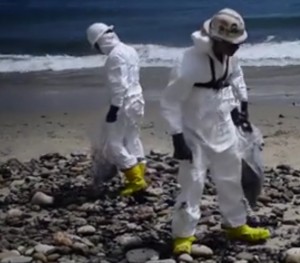
Hazmat-suited workers continue to clean up the oil-laden beaches at Santa Barbara’s Refugio State Beach on Friday and have been working around the clock after Tuesday’s rupture of an oil pipeline, owned by Plains All American Pipeline, sent thousands of gallons of crude flowing into the ocean and leaving an unsightly layer of black tarry goo on an estimated nine mile stretch of beaches in the area.
Although vessels have skimmed an estimated 9,500 gallons of the oil from areas off-shore from the affected beaches, officials say that the spill has already killed an undisclosed number of lobsters, kelp bass and marine invertebrates in the area. Pelicans and sea lions oiled by the slick are currently being retrieved and cleaned at rehabilitation centers.
Cleanup in the area may last for months, and it may take years to see the full impact of the spill. But, currently, the spill, affected by tides and currents is gradually being pulled off-shore from the area.
The cause of the rupture is still unknown as the pipeline carrying the crude is underground. Rick McMichael of the pipeline company said in a statement that the cause may take days to identify.
At three times the national average, Plains All American Pipeline has had 175 safety and maintenance violations in the past nine years.
One of Plains All American’s subsidiaries, Plains Midstream Canada suffered a rupture in an Alberta Canada forest in 2011. That oil spill spewed an estimated 1.176 million gallons of oil into the lakes and ponds there. That pipeline suffered an earlier rupture in 2006.
It was in 2014 that Plains had another pipeline burst in the streets of Los Angeles. 10,000 gallons flowed from a broken pipe then.
Other ruptures occurrred in Kansas, Oklahoma, Texas and Liousiana during the years 2004-2007. The EPA declared that the majority of those spills were caused corrosion in the pipelines.
The current spill in Santa Barbara occurred in the Las Flores-to-Gaviota pipeline that was built in 1987. Pipeline officials assured the populace that the pipeline had been inspected in the weeks prior to the spill.
Chairman of the pipeline company, Greg Armstrong, apologised for this most recent spill, saying, “We apologize for the damage that has been done to the wildlife and to the environment, and we’re very sorry for the disruption and inconvenience that it has caused the citizens and visitors of this area.”
